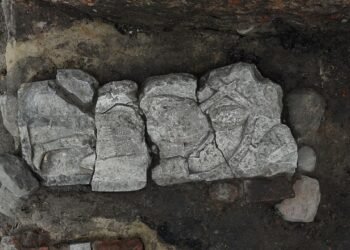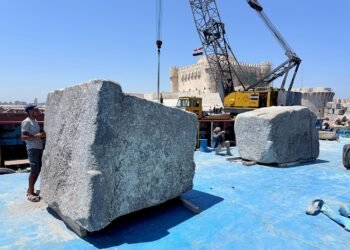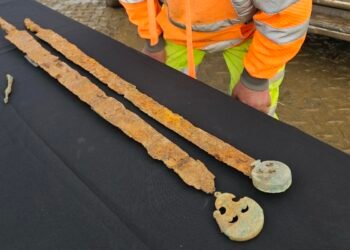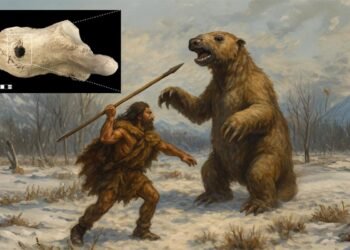Two exquisitely crafted gold necklaces, believed to be approximately 2,500 years old, have been stumbled upon by a worker for a local water company in northwestern Spain.

The necklaces, reminiscent of torcs, a type of ancient neck ornament, were found in Cavandi, Asturias, by Sergio Narciandi, who was carrying out routine work on August 29. Nestled among rocks, the first necklace gleamed with a mysterious history waiting to be unveiled. Promptly recognizing its significance, Narciandi reported his discovery, leading to a subsequent investigation by experts in the field.
Pablo Arias, a professor of prehistoric archaeology at the University of Cantabria, arrived at the scene, accompanied by specialists from the Asturias Archaeological Museum. The first necklace was found intact, while the second, though fragmented, held vital clues within its pieces.
The necklaces, dating back to around 500 BCE, transport us to the Iron Age, a time preceding the Roman Empire’s reign over the Iberian Peninsula. This era, characterized by Celtic populations, was notable for its distinctive metallurgical craftsmanship, particularly in the creation of ornate jewelry denoting wealth and social status.
While gold necklaces from this period have been unearthed in Spain before, most of these discoveries occurred in the 18th and 19th centuries, lacking detailed records of their origin. This newfound site remains intact, presenting archaeologists with a unique opportunity to understand their historical context better.
The intricate wear patterns on the necklaces suggest that they were not mere ornaments but rather precious symbols of status, worn primarily by the upper echelons of society. It’s a testament to the skill and craftsmanship of the goldsmiths of that era, reflecting the Celtic tradition of crafting such items from central rods with wound gold spirals.
These necklaces are likely part of a larger treasure trove, possibly hidden intentionally, as was common during the Bronze and Iron Ages in Atlantic Europe. Their burial may have been in a wooden or leather container, which has long since decayed, leaving only these magnificent pieces behind.
Researchers are conducting non-invasive metallurgic analysis and surface examinations to unveil further information about the manufacturing technology of Iron Age Spain, the source of the metals, gilding techniques, and more. Such comprehensive analysis is vital for understanding the broader historical and cultural context in which these necklaces were created and used.
The discovery has prompted excitement among experts, including Ángel Villa, an expert at the Archaeological Museum of Asturias, who emphasized the significance of these necklaces in gaining a deeper understanding of the customs, technology, cultural roots, and social organization of the Iron Age.
The profound archaeological importance of the find lies not solely in the objects themselves but in the context in which they were found. Sergio Narciandi’s swift reporting of his discovery has been lauded by the regional government in Asturias, as it has opened up a new chapter in the study of Iron Age gold work.























